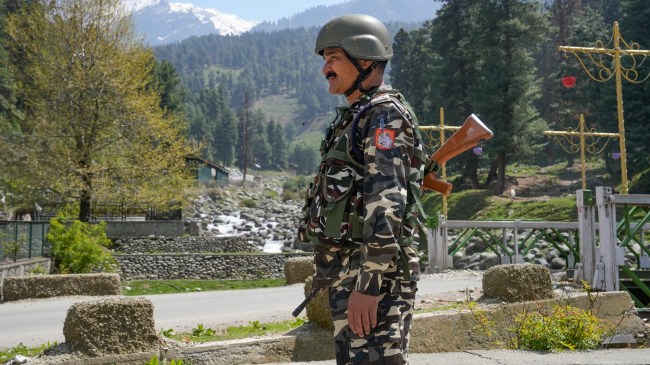Opinion Pahalgam terror attack is a grave reminder that peace is vulnerable, calls for a policy reset
Today, Kashmir faces a new breed of militancy. The hybrid terrorism of groups like The Resistance Front calls for a return to the fundamentals: Boots on the ground, human intelligence, an active CI grid, and political will
 Pahalgam: A security personnel stands guard a day after a terrorist attack in Pahalgam, J & K, Wednesday morning, April 23, 2025. (PTI Photo)
Pahalgam: A security personnel stands guard a day after a terrorist attack in Pahalgam, J & K, Wednesday morning, April 23, 2025. (PTI Photo) A ruthless act of terror has shattered the serenity of Pahalgam. It is yet another chilling reminder that peace in the Kashmir Valley remains precarious. With the recent attack claiming innocent lives, it’s time to confront a hard truth: Complacency and misjudgment are proving just as dangerous as enemy guns.
This wasn’t just an attack on civilians — it was a calculated strike on India’s credibility, timed with the visit of US Vice President JD Vance. Today, Kashmir faces a new breed of militancy. Intelligence estimates indicate the presence of around 60 foreign terrorists in the Valley. Half of them are linked to The Resistance Front (TRF) — a proxy outfit for Lashkar-e-Taiba, operating under a softer, more local-sounding label to dodge global scrutiny.
What makes TRF and similar groups more dangerous is their adoption of hybrid terrorism. This model doesn’t rely on trained gunmen in fatigues crossing the Line of Control. It uses radicalised locals, operating as civilian shadows, who are handed pistols or grenades to carry out targeted attacks, and then vanish into the crowd. These one-time operatives leave behind no digital footprint, no family linkages, and no predictable pattern for the security grid to follow. It’s terrorism by stealth and tailor-made to frustrate conventional intelligence and policing.
Vance’s high-profile visit should have been enough to tighten the net across sensitive areas. Instead, there appears to have been a weakening of proactive threat assessment and preventive deployment.
The apparent relaxation of area domination patrols is even more alarming, particularly in stretches not under 24/7 electronic surveillance. The belief that drone feeds and geofencing alone can secure mountain routes is not just flawed — it’s dangerous.
There is no substitute for physical presence in mountainous terrain. Drones can scan, cameras can record, and communication intercepts can trigger alerts — but none of this replaces the intuition, presence, and deterrence that boots on the ground provide.
The counter-insurgency grid needs immediate reinforcement. It must shift from reactive to pre-emptive. Routes to tourist hotspots like Pahalgam, Gulmarg, and Sonmarg must be brought under a layered security framework with permanent patrol units and rotational reconnaissance squads.
The Active CI Grid, once a success story post-Uri and Pulwama, appears to have loosened in parts. This review must be immediate, ruthless, and political hesitancy must not delay what is now a national security priority.
We also witness the consequences of a breakdown in local human intelligence (HUMINT). Hybrid terrorists do not belong to traditional networks. Their recruitment is short-cycle, often online, and their missions are one-off. They do not live in militant hideouts or speak in coded phone calls.
This necessitates deep, real-time intelligence from the ground — from inside mohallas, schools, madrassas, markets. Technology has its place, but in Kashmir’s shadow war, HUMINT is irreplaceable. Building trust with local informants, using low-profile field agents, and embedding assets into civil society are not luxuries — they are the backbone of early detection.
Let’s be blunt: “Aman ki Asha” is off the table for now. Dialogue with Pakistan has no meaning when its military establishment continues to nurture, protect, and export terror. There can be no talks, no handshakes, and no backchannels until cross-border terrorism is ended.
Beyond the tactical fallout, this attack has strategic consequences for the Kashmir Valley. In recent years, tourism has picked up dramatically. With over two crore domestic and foreign tourists in 2023, Kashmir felt hopeful again.
Now, that confidence is cracked. Tourists will cancel bookings, airlines will scale back flights, and hotels and houseboats will see empty rooms. The economic loss to local Kashmiris will be staggering, and once again, they will face the impossible dilemma of surviving in a conflict economy.
We must remain vigilant that counter-terror operations do not alienate ordinary citizens. The line between fighting terror and vilifying communities must not be crossed. The people of Kashmir are victims of both foreign-fueled terror and political instability.
There is also a strong case to review the leadership structure across the Valley’s security and intelligence hierarchy. A terror attack of this scale does not happen in a vacuum. Whether it’s lapses in threat perception, poor inter-agency coordination, or failure to act on existing inputs, accountability must follow. Rhetoric without restructuring is meaningless.
Leadership in Kashmir cannot be symbolic — it has to be operational. Those entrusted with national security must deliver results or make way for those who will.
This summer in Kashmir will be harsh because of what lies ahead. CI operations will intensify. The return of security dominance may bring back curfews, cordon-and-search operations, and tension across the Valley.
This will test the resilience of local communities and the maturity of Indian statecraft. While fighting the enemy across the border, we must protect the idea of India within.
most read
Pahalgam’s carnage is not just a terror attack — it’s a call to reset. Reset the way we think about hybrid terrorism. Reset our approach to intelligence. Reset the security posture. And reset our illusions about Pakistan.
It’s time to return to the fundamentals: Boots on the ground, HUMINT in place, an active CI grid, and political will. We must prepare for the long haul — to reestablish that India’s internal peace is not negotiable at gunpoint.
The writer served in the Indian Army, Armoured Corps, 65 Armoured Regiment





